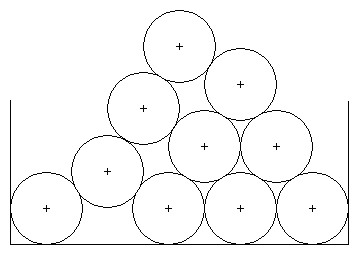标签:vector set images 坐标 mos sample ram 2.0 sig
题目链接:
http://poj.org/problem?id=2194
题目描述:
Description

Input
Output
Sample Input
4 1.0 4.4 7.8 11.2 1 1.0 6 1.0 3.0 5.0 7.0 9.0 11.0 10 1.0 3.0 5.0 7.0 9.0 11.0 13.0 15.0 17.0 20.4 5 1.0 4.4 7.8 14.6 11.2 0
Sample Output
6.1000 4.1607 1.0000 1.0000 6.0000 9.6603 10.7000 15.9100 7.8000 5.2143
题目大意:
圆从最底层开始摞,求最上面的球的横纵坐标
思路:
枚举层
用当前层两个相邻圆去构造新圆
很容易可以求出圆心夹角
旋转向量即可
代码:
1 #include <iostream> 2 #include <cstdio> 3 #include <algorithm> 4 #include <cmath> 5 #include <cstring> 6 using namespace std; 7 8 const int N = 12; 9 const double EPS = 1e-10; //精度系数 10 const double PI = acos(-1.0); //π 11 12 struct Point { 13 double x, y; 14 Point(double x = 0, double y = 0) :x(x), y(y) {} 15 const bool operator < (Point A)const { 16 return x == A.x ? y < A.y : x < A.x; 17 } 18 }; //点的定义 19 20 typedef Point Vector; //向量的定义 21 22 Vector operator + (Vector A, Vector B) { return Vector(A.x + B.x, A.y + B.y); } //向量加法 23 Vector operator - (Vector A, Vector B) { return Vector(A.x - B.x, A.y - B.y); } //向量减法 24 Vector operator * (Vector A, double p) { return Vector(A.x*p, A.y*p); } //向量数乘 25 26 int dcmp(double x) { 27 if (fabs(x) < EPS)return 0; else return x < 0 ? -1 : 1; 28 } //与0的关系 29 30 Vector Rotate(Vector A, double rad) { 31 return Vector(A.x*cos(rad) - A.y*sin(rad), A.x*sin(rad) + A.y*cos(rad)); 32 } //逆时针旋转rad度 33 34 double Dot(Vector A, Vector B) { return A.x*B.x + A.y*B.y; } //向量点乘 35 double Length(Vector A) { return sqrt(Dot(A, A)); } //向量长度 36 37 Point Up(Point A, Point B) { 38 Vector v = B - A; 39 double L = Length(v), rad = acos(L / 4); 40 Vector u = Rotate(v, rad); 41 return A + u*(2 / L); 42 } 43 44 int main() { 45 int n; 46 Point P[N][N]; 47 while (cin >> n && n) { 48 for (int i = 0; i < n; ++i) 49 scanf("%lf", &P[0][i].x), P[0][i].y = 1; 50 sort(P[0], P[0] + n); 51 for (int i = 1; i < n; ++i) 52 for (int j = 0; j < n - i; ++j) 53 P[i][j] = Up(P[i - 1][j], P[i - 1][j + 1]); 54 printf("%.4lf %.4lf\n", P[n - 1][0].x, P[n - 1][0].y); 55 } 56 }
POJ2194 Stacking Cylinders(向量旋转)
标签:vector set images 坐标 mos sample ram 2.0 sig
原文地址:http://www.cnblogs.com/hyp1231/p/7100311.html